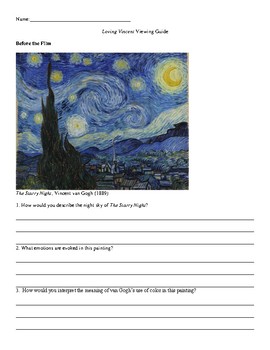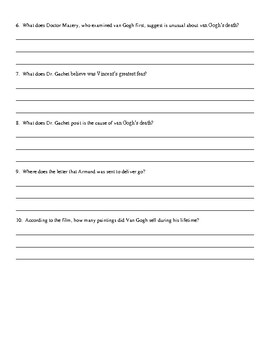Loving Vincent Viewing Guide (Vincent van Gogh Animated Film)
Pushing Stone Education
60 Followers
Grade Levels
9th - 12th
Subjects
Resource Type
Standards
CCSSRI.9-10.1
CCSSRI.9-10.2
CCSSRI.9-10.3
CCSSRI.9-10.4
CCSSRI.9-10.7
Formats Included
- PDF
Pages
11 pages
Pushing Stone Education
60 Followers
What educators are saying
Loved this! I especially loved the before and after questions! My students were surprised when I actually tried to make them think deeper about things! The questions are spaced out a good amount which is nice. A lot of them are relevant and not just busy work.
Description
Loving Vincent is a biographical film about the last days of Vincent van Gogh's life animated in the style of van Gogh's paintings. The film is a creates discussion and mystery around the circumstances of his death and allows the integration of nonfiction texts into the lesson.
This viewing guide provide three questions that analyzes The Starry Night followed by ten questions to be answered during the film. After viewing the film, three deeper questions ask students to analyze the style and content of the film. If you're looking for ways to introduce reading skills into your classroom, I have also provided two nonfiction readings with questions: an excerpt from a letter written from Vincent to his brother Theo and a nonfiction article about a possible medical diagnosis of vertigo for van Gogh. Finally, an answer key for all the questions is provided.
This viewing guide provide three questions that analyzes The Starry Night followed by ten questions to be answered during the film. After viewing the film, three deeper questions ask students to analyze the style and content of the film. If you're looking for ways to introduce reading skills into your classroom, I have also provided two nonfiction readings with questions: an excerpt from a letter written from Vincent to his brother Theo and a nonfiction article about a possible medical diagnosis of vertigo for van Gogh. Finally, an answer key for all the questions is provided.
Total Pages
11 pages
Answer Key
Included
Teaching Duration
3 hours
Report this resource to TPT
Reported resources will be reviewed by our team. Report this resource to let us know if this resource violates TPT’s content guidelines.
Standards
to see state-specific standards (only available in the US).
CCSSRI.9-10.1
Cite strong and thorough textual evidence to support analysis of what the text says explicitly as well as inferences drawn from the text.
CCSSRI.9-10.2
Determine a central idea of a text and analyze its development over the course of the text, including how it emerges and is shaped and refined by specific details; provide an objective summary of the text.
CCSSRI.9-10.3
Analyze how the author unfolds an analysis or series of ideas or events, including the order in which the points are made, how they are introduced and developed, and the connections that are drawn between them.
CCSSRI.9-10.4
Determine the meaning of words and phrases as they are used in a text, including figurative, connotative, and technical meanings; analyze the cumulative impact of specific word choices on meaning and tone (e.g., how the language of a court opinion differs from that of a newspaper).
CCSSRI.9-10.7
Analyze various accounts of a subject told in different mediums (e.g., a person’s life story in both print and multimedia), determining which details are emphasized in each account.





